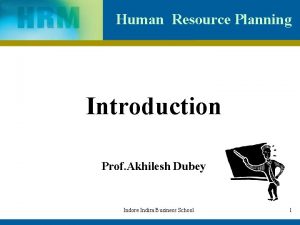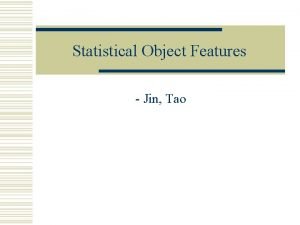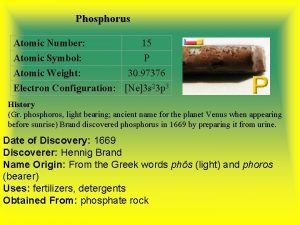FROM ATOMIC ENERGY CENTRAL SCHOOL INDORE MODULE33 1













- Slides: 13

FROM: ATOMIC ENERGY CENTRAL SCHOOL, INDORE MODULE-3/3 1

Class: IX MOMENTS: The Happy Prince By- Oscar Wilde 2

Content: q 1) Theme of the story I) Social Injustice II) Love and Sacrifice III) Appearances can be deceptive IV) Exploitation and hypocrisy of the ruling class of society: V) True Friendship q 2) Use of Allusions q 3) Moral Values q 4) Conclusion 3

Theme of the story: I) Social Injustice: Oscar Wilde shows the double standard of society the rich people of society are in the enjoyment of all luxuries but poor people are devoid of basic necessities. This social injustice is best satirised in the happy prince the first victim of this injustice is poor seamstress who is in poor condition and is not able to do something for her child. She is helpless waiting for the time to take its turn. With her hands she can stitch the gown of a maid of the queen yet with these hands she cannot cure her child. The writer’s state of depression makes our hearts rebel against this unfair distinction and the pleasures of the rich are more valuable than the life of individuals. The second victim we see is the young man in the garret, who had “large and dreamy eyes”. But the cruel society had snatched the dreams from his eyes and stuffed them with gloominess of poverty. 4

II) Love and Sacrifice: The compassion of the bird and the statue for other people depicts great sensitive feelings. The prince gives away everything to help people. The Swallow and the prince share a fantastic bond of love. While the prince gives away his ruby, eyes and gold leaves, the little Swallow sacrifices his life to serve humanity. The bird did not reach Egypt to meet its companions, instead stayed with the prince in harsh cold weather and at last died at the feet of the statue. 5

III) Appearances can be Deceptive: �This story has a great lesson to teach as it portrays a statue coated in gold but basically it is made up of the metal. The appearance was grand but when all gold coating came off, the statue looked ugly. Another thing associated with this is that the prince was happy when he was alive and enjoyed his wealth but the time he saw human beings suffering, he was saddened by the poverty and pain around him. 6

IV) Exploitation and hypocrisy of the ruling class of society: This theme is vibrant in the story as the Mayor and his members of the office judged the statue and chose to pull it down. They thought that it was looking ugly so useless and should be demolished. Also, the happy prince lived in his palace not knowing the misery of human beings as he never bothered to look beyond the huge walls of his palace. The rich live lavishly and the poor are not treated well. ØIn other sense Oscar Wilde rightly says: “I hope you have not been leading a double life, pretending to be wicked and being really good all the time. That would be hypocrisy. ” 7

V) True Friendship: � The prince in the story shares a great bond of friendship and respect with the little swallow. Whatever the prince commands, the swallow follows the orders religiously. The friendship they had was so true and loyal that they were put in the heaven together. �“True friends stab you in the front. ” 8

Use of Allusions: �The words as “Happy Prince ”and “Little swallow” convey the message that swallow is greater in grandeur than any human being due to his act of sacrifice while the prince is no more happy when he sees the plight of poor people. �“How shabby the Happy Prince looks!” , “ Little better than a beggar!” – such remarks reveal the prevailing nature of the society that the outward beauty or appearance of the person matters more than his virtues. �. . . . “no longer beautiful. . . No longer useful”- shows the tendency of the people i. e. ‘Use and Throw. ’ 9

Moral Values: � 1. There will be good rewards for those who feel pity for the poor and make sacrifices to remove miseries and sufferings of other people. � 2. The outward beauty doesn't meant a lot, the real beauty is in the person's heart which have the deep feelings and the ability to feel the sorrow and hardship of other. 10

CONCLUSION: �To sum up all the above discussion, we can say that “The Happy Prince” is a masterpiece which shows so many aspects of life. Oscar wild has shown the fancy and imagination one side while on the other side he has unveiled the hypocrisy, Poverty, greed and temptation of people. This is a satiric document on the Victorian society; love and innocence are the living forces. Oscar Wilde has manifested so many stylistic devices which have transformed the story into a great literary work. 11

12

13
 Atomic energy central school indore
Atomic energy central school indore Atomic energy central school
Atomic energy central school Atomic energy central school narora
Atomic energy central school narora Star india container line pvt. ltd
Star india container line pvt. ltd Lokesh kumar jangid
Lokesh kumar jangid Dr akhilesh dubey indore
Dr akhilesh dubey indore Open for delivery meaning
Open for delivery meaning Tax practitioners association indore
Tax practitioners association indore Threshold
Threshold Sanjay dubey ias
Sanjay dubey ias Akash tripathi indore
Akash tripathi indore Relative atomic mass of beryllium
Relative atomic mass of beryllium Trends in the periodic table
Trends in the periodic table Radius size trend
Radius size trend
























